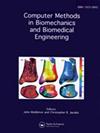基于肌电图的多肌肉疲劳模型研究操作任务表现。
IF 1.7
4区 医学
Q3 COMPUTER SCIENCE, INTERDISCIPLINARY APPLICATIONS
Computer Methods in Biomechanics and Biomedical Engineering
Pub Date : 2025-05-27
DOI:10.1080/10255842.2025.2510369
引用次数: 0
摘要
通过结合基于肌电图(EMG)的振幅和频率参数、快慢抽动肌纤维比率、线性化时间累积效应的时间乘数和标准化所考虑的肌肉数量的综合效应的肌肉乘数,我们开发了一个多肌肉疲劳模型(MMFM)。我们通过研究10名男性受试者使用0.91 kg和2.72 kg哑铃执行一个持续到筋疲力尽的静态任务和两个重复的动态任务(低和高任务难度水平)的疲劳发展模式来验证该模型。结果表明MMFM对疲劳相关的神经肌肉变化敏感,能准确预测肩关节疲劳。本文章由计算机程序翻译,如有差异,请以英文原文为准。
An electromyography-based multi-muscle fatigue model to investigate operational task performance.
We developed a multi-muscle fatigue model (MMFM) by incorporating electromyography (EMG)-based amplitude and frequency parameters, the fast-to-slow twitch muscle fiber ratio, a time multiplier to linearize the cumulative effect of time, and a muscle multiplier to standardize the combined effect of the number of muscles being considered. We validated the model by investigating fatigue development patterns of 10 male subjects performing one sustained-till-exhaustion static and two repetitive dynamic tasks (low and high task difficulty levels) using 0.91 kg and 2.72 kg dumbbells. The results indicated that the MMFM was sensitive to fatigue-related neuromuscular changes and predicted shoulder joint fatigue accurately.
求助全文
通过发布文献求助,成功后即可免费获取论文全文。
去求助
来源期刊
CiteScore
4.10
自引率
6.20%
发文量
179
审稿时长
4-8 weeks
期刊介绍:
The primary aims of Computer Methods in Biomechanics and Biomedical Engineering are to provide a means of communicating the advances being made in the areas of biomechanics and biomedical engineering and to stimulate interest in the continually emerging computer based technologies which are being applied in these multidisciplinary subjects. Computer Methods in Biomechanics and Biomedical Engineering will also provide a focus for the importance of integrating the disciplines of engineering with medical technology and clinical expertise. Such integration will have a major impact on health care in the future.

 求助内容:
求助内容: 应助结果提醒方式:
应助结果提醒方式:


